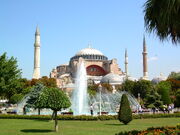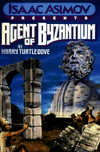
Hagia Sophia (/ˈhɑːɡiə soʊˈfiːə/; from Koinē Greek: Ἁγία Σοφία, romanized: Hagía Sophía; Latin: Sancta Sophia, lit. 'Holy Wisdom'; Turkish: Ayasofya), officially the Hagia Sophia Holy Grand Mosque (Turkish: Ayasofya-i Kebir Cami-i Şerifi), and formerly the Church of Hagia Sophia, is a Late Antique place of worship in Istanbul, designed by the Greek geometers Isidore of Miletus and Anthemius of Tralles. Built in 537 under Byzantine emperor Justinian I as the patriarchal cathedral of the imperial capital of Constantinople, it was the largest Christian church of the eastern Roman Empire (the Byzantine Empire) and the Eastern Orthodox Church, except during the Latin Empire from 1204 to 1261, when it became the city's Latin Catholic cathedral. In 1453, after the fall of Constantinople to the Ottoman Empireit was converted into a mosque. In 1935, the secular Turkish Republic established it as a museum. In 2020, it re-opened as a mosque.
Hagia Sophia in Agent of Byzantium[]
Basil Argyros and his wife Helen went to pray at the Hagia Sophia during their life together.[1]
In 1317, Patriarch Eutropios read his anathema against iconoclasm at the great church.[2]
Hagia Sophia in "The Emperor's Return"[]
On 29 May 1453, Emperor Constantine XI Palaiologos entered the Hagia Sophia as the Ottoman Empire overran Constantinople. After informing a priest that he would not flee, Constantine asked for a miracle: for God to let him see the city in Christian hands again.
With that, a mantle of flame bathed the emperor, and he sank into the marble floor before the eyes of the startled priest. Constantinople fell shortly after, and Constantine's body was never found.
On 7 June 2003, Istanbul was overrun by Greece and the Soviet Union during their war with Turkey. Four Greek soldiers entered the Hagia Sophia. Early in the fighting, Turkish snipers had used a minaret as a roost, until a Greek jet destroyed it.
With the city back in Christian hands, Constantine XI awoke from his slumber shortly after the soldiers entered. Once he announced his intention to assert his rule again, Greek sergeant Yannis Pappas gunned the Emperor down and left his body in the Hagia Sophia.
Hagia Sophia in "The Fake Pandemic"[]
The Hagia Sophia in Constantinople was completed just prior to Tribonian's journey to Florence, Ostrogothic Italy. When he arrived in Florence, he found their basilica wanting compared with the Hagia Sophia.[3]
References[]
- ↑ Agent of Byzantium, 2018 edition, pgs. 49-51.
- ↑ Ibid., pgs. 235-236.
- ↑ Lest Darkness Fall & Timeless Tales Written in Tribute (second edition), pgs. 380, loc. 4971.
| |||||||||||||
| |||||||||||
| |||||
